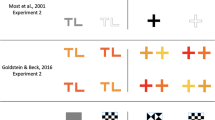Abstract.
Object-based visual attention is observed when the benefit of attending to one element in a display extends to other elements that are part of the same perceptual object. Apperceptive agnosia is an object identification deficit in which spatial attention is preserved but object-based attention is impaired. Some debate exists regarding the extent to which the object-based impairment can be attributed to perceptual mechanisms that are specifically involved in grouping and segmentation of a scene, as opposed to early sensory processes. In the present paper we show that random visual noise is sufficient to eliminate the object benefit, a result inconsistent with the view that grouping mechanisms are responsible for the effect. The results have implications for an understanding of apperceptive agnosia, and for an understanding of object-based attention more generally.
Similar content being viewed by others
Author information
Authors and Affiliations
Additional information
Electronic Publication
Rights and permissions
About this article
Cite this article
Abrams, R.A., Law, M.B. Random visual noise impairs object-based attention. Exp Brain Res 142, 349–353 (2002). https://doi.org/10.1007/s00221-001-0899-2
Received:
Accepted:
Issue Date:
DOI: https://doi.org/10.1007/s00221-001-0899-2




